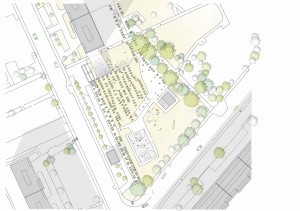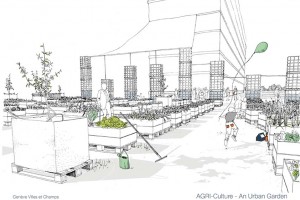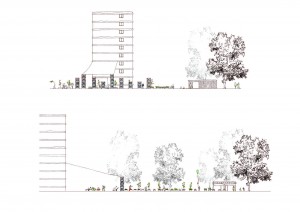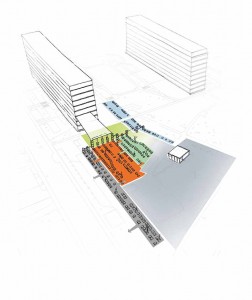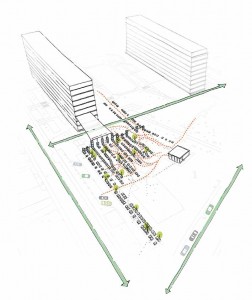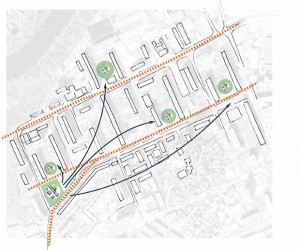AGRI-Culture addresses three basic topics: the recovery and reclamation of water, the growing, planting, harvesting and
celebrating of food and the appropriation and animation of place.
WATER RECUPERATION
Rainwater harvesting is an essential component to successful
urban agriculture projects. Neighborhoods like these provide massive rooftop collection surfaces and a large potential for water recuperation and reuse. Unfortunately, re-configuring the drainage conditions of the flat-roofed housing bars and redirecting the collected water towards cisterns is a major challenge.
If possible, AGRI-Culture proposes to implement such a solution to fill its cisterns. However, if this proves unfeasible, the garden takes advantage of its own shade and rain canopy to collect a portion of its water. This broad colorful canvas catches a considerable volume of water, it also marks the center of event activity on the site and physically joins the garden to its adjacent housing building.
PLANTS FOR FOOD
The boxes used for the planting are recycled Swiss wooden
shipping crates once used to transport fruit. The planted boxes are
of two types: collectively or individually planted. The collectively planted boxes are seeded and planted by the project team at the beginning of the season and maintained by the Genève, villes et champs organizers or an interested collective group.
They include aromatics, vegetables and small fruits, fruit trees and flowers. Particular care is given to representing ancient or unusual varieties and to productive plant associations / combinations.
The individually planted boxes vary per gardener and must follow an agreed upon charter of management.
PLACE
Appropriation of the site by its nearby residents is one of the
main objectives of this urban garden. This relies on the support of a local association to organize and coordinate the people who are interested in planting and
maintaining a small plot. Following the identification of interested gardeners by such an association, the urban garden is divided according to the respective collective and individual modes of management. The more individuals are attracted to the project, the fewer collectively planted and maintained boxes there will be.
The compilation of plant-boxes on this site should provide value not only to the visitors of the Genève, villes et champs event, but also, or even more importantly to those from the neighborhood who will begin a long-term engagement in the act of urban gardening, food production and caring for a shared space.
Throughout the duration of the five months, the urban garden provides the framework for summertime activities and events. Concentrated around five food themes: film, plants, cooking,
market, and kids, this program draws energy to the garden,
attracts visitors and brings new social engagement. The urban garden activities must be closely coordinated and programmed with the support of the organizers of Genève, villes et champs. They are to include: Food films, Plant talks & workshops, Cooking workshops, a Farmer’s market, Kids’ animations.
OBJECTIVES
AGRI-Culture seeks to add a new dimension to urban culture by inserting a fresh landscape experience. It aims:
– to activate and energize a corner of a residential neighborhood,
– to add different dimensions to urban park appropriation,
– to create a demonstration vegetable garden,
– to raise awareness about urban water recuperation,
– to demonstrate that local citizens are interested in actively participating in food production,
– to extend the socio-cultural space in front of the community center by introducing the act of planting and its associated activities,
– to take advantage of the diversity of the neighborhood and bring together different types of people around a common interest,
– to encourage new social interactions within the already dense community,
– to encourage citizens to appropriate their own plant-box for the event as well as for the coming years.
FUTURE LIFE
Genève, villes et champs is an ephemeral event, however after the
closing, the proposed temporary planting boxes may be adopted on the site or transported elsewhere. Through a systemic approach of box
dissemination in nearby currently underused spaces, AGRI-culture carries the opportunity to bring about broader neighborhood impact in the future. Like the event, the materiality of the project is ephemeral.
The plant boxes are stackable, deliverable and easily set into place. They are suitable for sites with contaminated or heavily compacted soil or sites with short-term limits. The material investment into the project is intended to outlive the instrument that facilitated its creation, the Villes et champs manifestation.
To aid in re-using the plant boxes, during the manifestation, a list of future adoptive plant-box gardeners will be compiled and sites will be determined (based upon gardeners’ place of residence and the availability of un-used or under-used sites).
The seeds of the events may bear fruits elsewhere in the future.
BENEFITS
AGRI-Culture posits that multiple benefits may emanate from the insertion of an urban garden of this type.
Urban integration
Small community managed vegetable gardens can positively affect urban integration by creating new synergies,
increasing the diversity and heterogeneity of public spaces, contributing to the city’s landscape and environmental network, adding connections along existing paths network, and characterizing the identity of its neighborhood.
Spatial / architectural quality
The positive contribution of “green space” to urban life is widely
recognized and the demand for more “nature in the city” is increasing. “Fertile or cultivated nature” brings into the city some of the spatial qualities of productive landscapes and sets them into juxtaposition and dialog with the built environment.
Small scale food production surfaces make better use of under-
used or residual spaces and provide attention and care to currently neglected or untended sites.
Planted, well-organized and dynamically changing cultivated urban patches can increase the aesthetic quality of a neighborhood as well as contribute to its spatial organization.
Carefully organized community gardens can attract new
gardeners and become models of replication.
Urban food productivity
Urban agriculture has the potential to provide an increased
access to fresh and healthy unprocessed food.
Gardening on such a scale can be remarkably productive when it is managed attentively (3 to 5 kg of produce / m2).
Environmental viability
Local food production can increase the opportunity for biodiversity by offering a wide range of plant species and providing habitat for animal species such as birds and insects.
Productive surfaces might increase a city’s capacity to better retain its stormwater.
Increased soil and vegetation decreases the urban heat island effect.
High levels of CO2 can be beneficial for plant production.
Social cohesion
Gardening can instigate celebration around key seasonal moments, such as planting and harvesting, helping to construct temporal
rituals, enhance one’s connection to nature and seasonal cycles, and contribute to the experience of place and sense of belonging.
Collectively managed gardens allow those with less available time or energy to still participate in and benefit from the social advantages associated with the group activity.
Economic viability
In-kind income is generated from the produce of a family garden. In communities with greatest economic insecurity, local food production can increase individual and local food security.
The urban population is growing more concerned with the provenance and quality of food and are expressing interest in investing more time into gardening activities and willingness to spend more for urban produce.
Management
There is an opportunity for urban authorities to develop partnerships with community organizations so as to share in the management of certain public or collective spaces. Neighborhood contracts are an existing example of partnerships, aimed at improving the
quality of urban life.
Local food production searches to establish
connections with neighborhood community centers, canteens, large community kitchens, schools, homes, etc, which together can help enhance viability.
Conclusion
Through the creation of a temporary garden to test the effectiveness of a small-scale collective urban agricultural
intervention, AGRI-Culture investigates how increased quality of life can be attained through the thoughtful integration of food production into the urban fabric.
Ville et champs 2014 project proposition by VWA.




